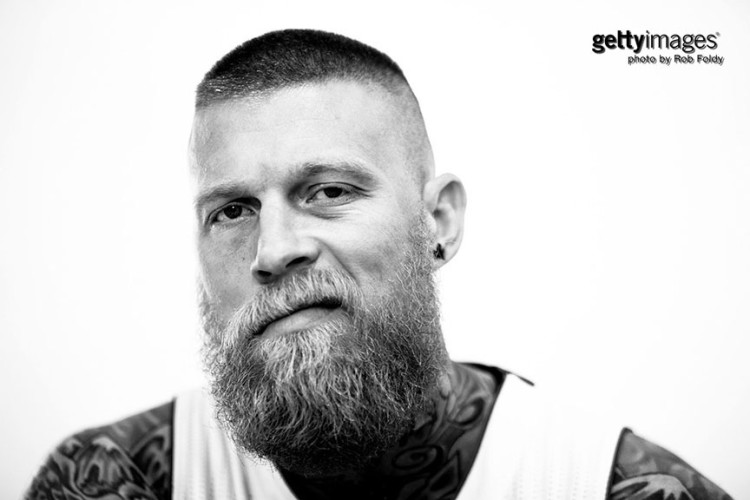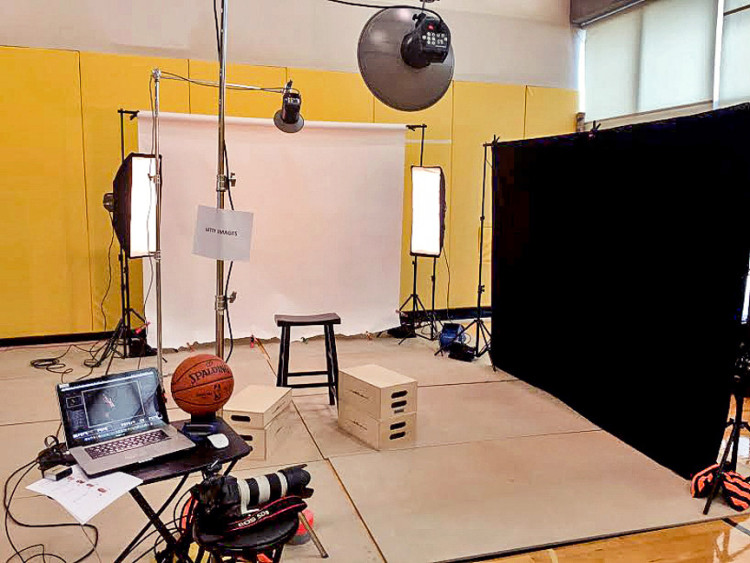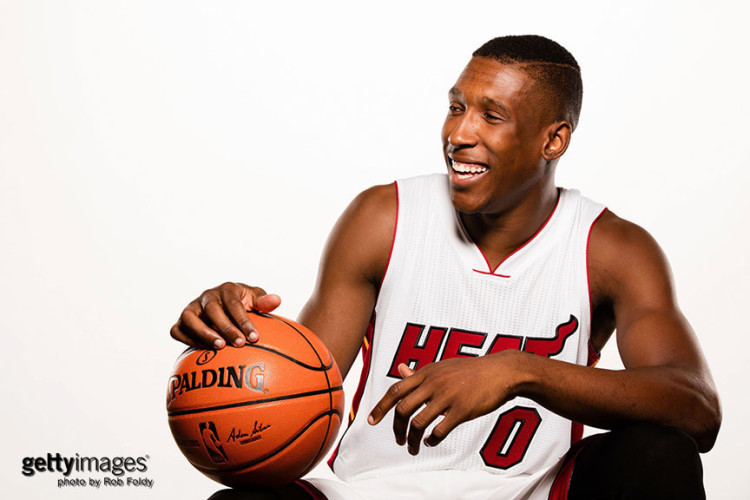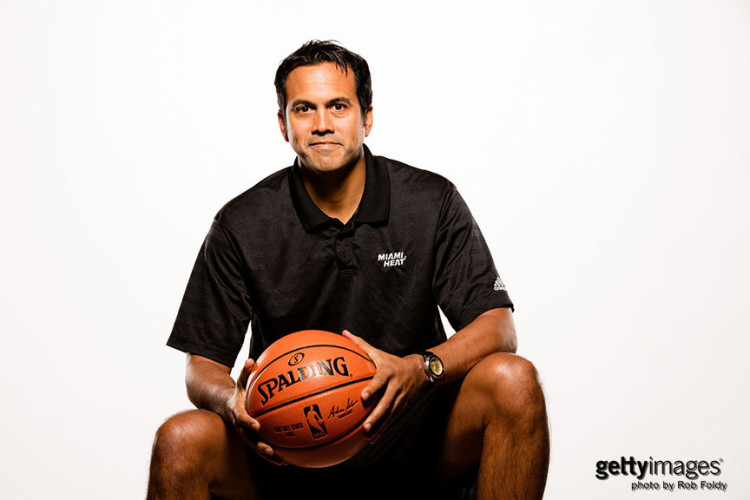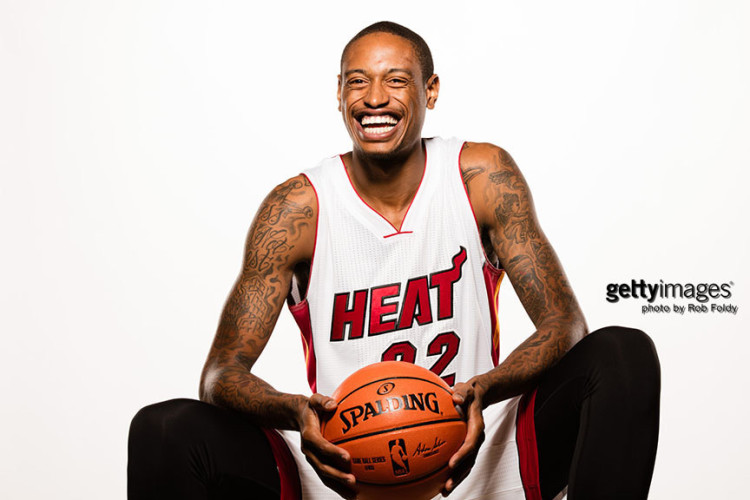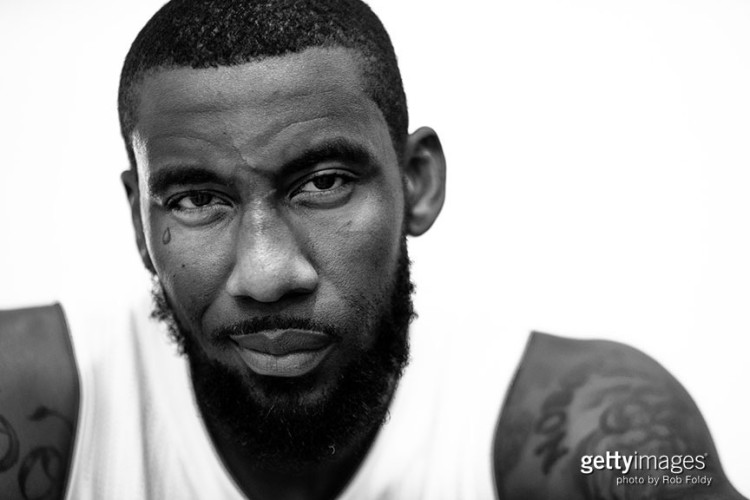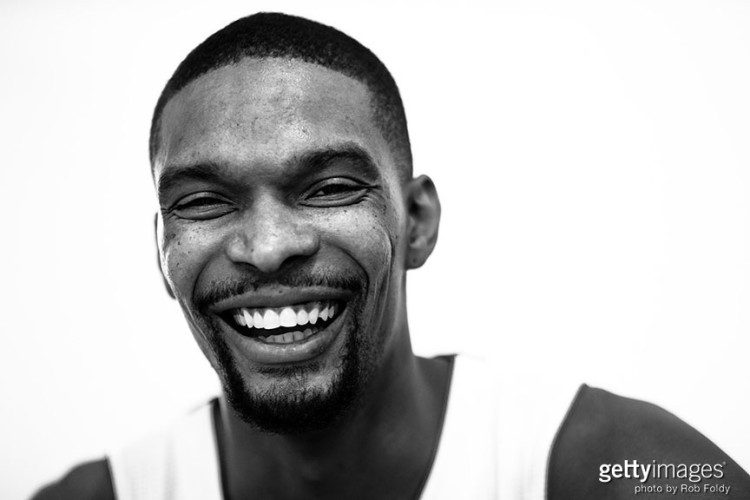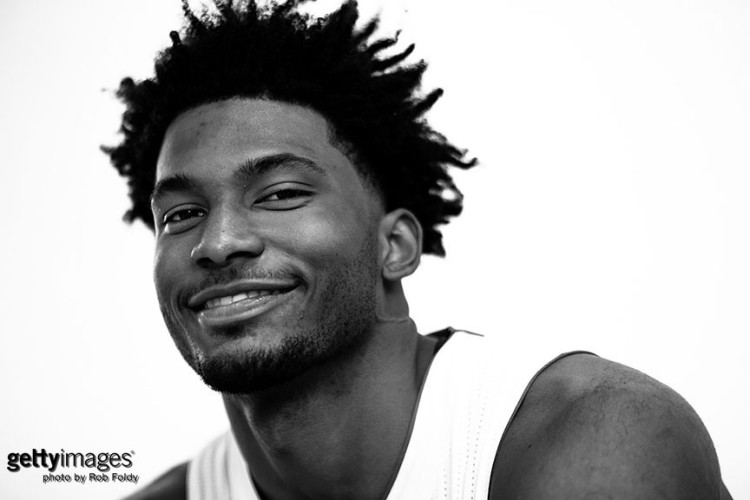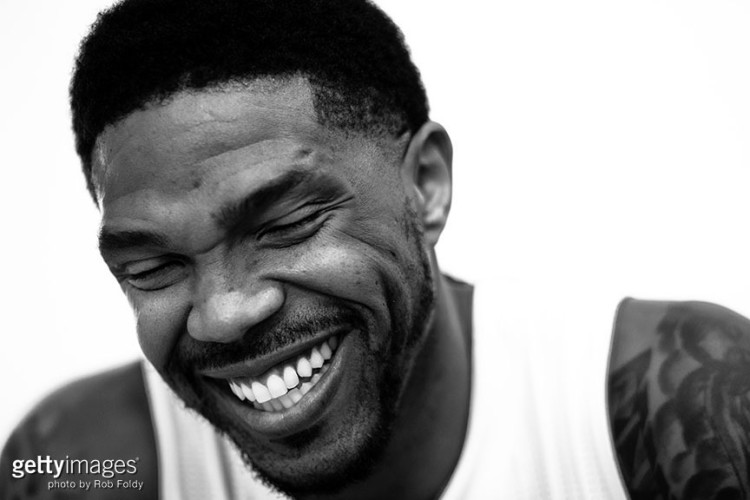Editor’s Note: Here’s a great post from 2015 featuring Robert Foldy’s walkthrough of his portraits of the Miami Heat on media day!
Hello everyone, I’m Robert Foldy and I’m a freelance commercial sports photographer based just outside of Nashville, Tennessee. I’ve been a friend of Scott and Brad’s for quite a while now and they have asked me to share with you some images and tales from a recent shoot. As always, I’m extremely humbled to be asked to share with you.
In 2015, I was asked to photograph each of the Miami Heat players before the start of the 2015-16 season for one of my clients, Getty Images. The most common opportunity to photograph professional or college athletes is on what’s called “media day.” If you’ve never heard of media day, it’s basically a day dedicated for all of the players on a team to fulfill various media needs, from still photographs to radio broadcasts to television interviews. This is a very busy day for the athletes. I’ve had the pleasure of covering a fair number of these over my career for different teams and organizations, and I’ve been able to pick up a few tips and tricks from others as well as stumbling upon some of my own.
Allow me to explain a bit more of how the photo section of these “media days” work. For basketball, most of the activity takes place on the practice court at the team’s home arena. The team/league, and typically a large local paper, will do photos as well, but traditionally in different locations around the arena. I don’t know exactly what else these players were required to participate in on that day, but I know there were at least 7 different sets of photographers from various newspapers and wire services set up and making portraits in the same room that I was in.
This is one of the first challenges. It’s a technical challenge with all of those strobes firing and all of the other distractions, but it’s also difficult to make a strong, unique image when these players are pumping out the same photos for various photographers as if they were on an assembly line. I don’t mean that to belittle any of those agencies or photographers, and those photos are very good and very important. However, my assignment was to make something different than the other photographers there that day, and I took it upon myself to strive for what I hoped to be a different image than anyone shooting any of the various teams and players throughout the country. Where as the other media day portraits are used for editorial work or television, the images from Getty are often used in advertising campaigns or for other commercial purposes.
I’ll start with the gear stuff. I know when I first started reading this blog the gear stuff is the first thing I’d look for. So if you’re like me, here you go. I used Elinchrom BRX monolights (a BRX250 and three 500s) with the Skyport triggering system, two Westcott strip banks for side/back lights, a basic Elinchrom reflector to light the background, and an Elinchrom beauty dish with the silver deflector (with and without the diffusion sock) as my front light. I shoot with both a Canon 5Ds body mounted to an EF 70-200mm f/2.8L IS II USM lens, and a 1DX body with an EF 85mm f/1.8 USM lens. The 50 plus megapixels of the 5Ds gave the images a ton of detail, while the low noise capabilities of the 1DX, along with the 12 frames per second motor drive, allowed me to shoot using just the modeling lights and capture the exact moment of the player’s expression that I was after.
I wore my Spider Holster dual camera system so that I could easily switch between camera bodies or have my hands completely free, and tethered into Lightroom on my laptop (just the 5Ds, as that was my “primary” camera). Every client wants things done a bit differently, and for Getty I always shoot JPEG. (I’ve had to familiarize myself with a lot of functions in my Canon cameras that I didn’t really know were there to help get my JPEGs as close to perfect as I can right out of the camera). I shot large JPEG plus RAW for this shoot just so I had a backup, but I’m proud to say that I was able to use my standard JPEG workflow for all of the photos that I delivered. Below is an iPhone photo of my setup.
As you can see, it’s not a typical portrait setup, so let me explain a little more about media day. Photographers get, on average, about 2 minutes with each of the players before they’re onto their next commitment. They move from one photographer directly to the next. How do I make good portraits, much less ones that are unique, in less than 2 minutes?! That’s where this dual background setup comes in. I can get two different looks with one lighting setup, without my subject really having to move or reposition. I cannot take any credit for this idea. A good friend and Getty staff photographer, Mike Ehrmann, told me about it and uses it himself, as do many other very talented shooters.
But, like anything I learn, I try to adapt it and make it my own. Although I used the two background idea that Mike had used, he traditionally uses it with all of the light coming from the front. It gets more difficult when you try to add lights behind the subject as well. But, if done correctly, I can get 3 different looks, each of those with a few different expressions, giving my clients a good variety despite only having the players for a short period of time.
I’ll start with my “main” setup. I shot these straight on, strobed, white background shots with the 5Ds and 70-200, ISO 100, 1/160th of a second, somewhere around f11. Before you give me too much grief about the players sitting down, like the great portrait photographer Peter Hurley did, let me explain to you why. I agree that most of the time portrait photographs look best when your subject(s) are standing, but there are a few problems with that on media day.
The first being that I’m trying to make a different photo than everyone around me, and everyone else has the athletes standing. But the main reason why I have them sit is more psychological than physical. I try to set up my little “portrait station” to be welcoming and comfortable. When the players walked up, instead of posing them and asking them to stand one way or the other, and then turn and pose some other way, I simply introduced myself and asked them to sit down, put their feet up, and make themselves comfortable. “Imagine you’re just chillin’ on your couch at home watching TV…except for some reason you’re holding a basketball.” I’ve found that an approach like this gets them out of the “routine” of media day, and into something along the lines of, “Wait a minute, I’ve never taken a photo like this before.” I try to make them feel relaxed. Sure I have an agenda/shot list in my head, but I don’t tell them that, I let the photographs come to me.
For this shot I knew I wanted some more serious photos, but also something with a bit of that specific player’s personality. If I were to ask them to smile, the players would just give me what I have nicknamed their “media day smile.” So if they did, I would jokingly say to them something along the lines of, “Come on man, that ain’t your real smile. Give me the smile you would give me if I told you I was sending this photo to your mom.” Bam. You’re in.
But photos of people smiling are a dime a dozen, so how do I make something different? Something genuine, something that really shows their personality, but do it in less than a minute? I have found a trick that seems to work pretty well for me. After I snap a few frames, I drop the camera in my Spider Holster and walk up to them like I’m about to tell them a secret. In the pros, a lot of these guys are married, so my conversation with them usually goes something like this: “Hey man, are you married? (If yes, keep going, if no, skip ahead a few lines.) Okay, well, let’s go back a few years to before you were married, okay? Okay, so you’re out at the club with your buddies, the place is packed, everyone is having a good time. You see this group of girls walk by and they are smokin’ hot. You realize one of them keeps checking you out, you think she’s worth getting to know a little better, so the next time you catch her looking your way, you give her ‘the look.’”
At this point, they are usually snickering because they know exactly the look you’re talking about. “You know the look I mean? I call it the ‘ay girl’ look.” (I now demonstrate my best attempt at the “look.”) “I’m going to walk back over there, but when I count to three, do you think you can give that look to the camera?” Admittedly it works on some guys right out of the gate and others not so much, but it gets them out of their own way and continues to get them to relax. If they try the look and it doesn’t work, that’s usually followed by laughter. Like Dr. Hurley says: sometimes it’s not the face you’re after, but the smile you get right after the face.
So at this point, hopefully they’re playing ball with you (yes, I just made a basketball pun). That’s when I holster the 70-200 and grab the 1DX with the 85mm. I have this camera set to Monochrome JPEG, and on the 1DX cameras you can adjust the sharpness and contrast, as well as apply filter and toning effects for black and white images right in the camera. My exposure settings were somewhere in the neighborhood of ISO 1600, f2 and 1/500th shutter. I shot these in black and white for a few reasons. One, I like black and white images. Two, I shot these only using the modeling lights from the flashes, so I knew a ton of mixed color temperature ambient light would be creeping into my photos and my white balance would be a mess.
Free from the tethering cable and not having to wait for lights to recycle, I was able to keep those looks and expressions coming while they were still trying to make a good “ay girl” face, and the subsequent laughter that follows. My good friend David Santiago from the Miami Herald took this photo of me while I was trying to shoot just that. (Oh yeah, that’s another distraction. In addition to the portrait shooters, a lot of papers or agencies will cover the event overall, so there are people shooting photos and video of you as you’re shooting photos of the athletes.)
I like to get in really close with the 85mm. It may make the subject a bit uncomfortable at first, but in the end, they’re all real human beings like us, and they want to look good in the photos. A lot of times they’ll ask to see the photos on the back of the camera. If they like them, you’re in even better shape moving forward.
I still know that I’m on a time crunch, so once I know I have what I need from the front, I tell the players that they’re almost done, I just have to make a few more frames. I re-holster the 1DX, grab the 70-200 again and head over to the side so I can shoot them against the black background. (Below is another photo from David Santiago. You can see another photographer’s setup right next to mine, and there’s another one next to that, and 4 more on the adjacent wall.)
This shot also requires some foresight. Remember how I mentioned that someone had told me about the two background idea, but that all of their light was coming from the front? Well, if I were to fire all 4 of my lights and shoot from the side, my photo would be a mess. There would be light spilling into the lens, the strip banks would probably be in the frame, and it would just not be the image I wanted. I’ve used other brands of lights and triggers in the past, and my work-around was to plug the background light and strip banks into a power strip and then just turn off the switch before taking the shot on the black background. That worked, but is not ideal. By using the Elinchrom Skyport system, I had the background light, the strip banks, and the beauty dish all in separate groups. This not only allowed me to turn each of the groups up and down individually, but also allowed me to fire just the beauty dish.
To close, I’d like share with you a story from a few years ago… I was shooting another team with a similar setup and was trying to use the same tricks. It was towards the end of the day and honestly I was starting to get tired. I was pretty far away from this player who was a bit larger than some of the other guys, so I was zoomed all the way in towards 200mm, and instead of walking over to him and really selling the “girls in the club” story, I kinda gave a brief explanation from across the room. After I’m finished I ask him for the “ay girl” look and he gives me something. Not perfect, but not bad. I shot a few more at that distance and then came in close with my 85. I ask “hey, give me that ‘ay girl’ look one more time.” “OH! You were saying ‘ay girl’, that makes a lot more sense. I thought you were saying ‘egg roll’.” I lost it. My assistant, the other photographers near by, the player’s handler, he and I we were all cracking up. “The rest of those guys were giving me that look thinking they were giving it to an attractive girl, you gave it to me for an egg roll!” “What can I say, man, I really like egg rolls.”
Thank you so much for taking the time to read this, and I hope it encourages you that, despite the obstacles you may be facing on any particular shoot, if you think outside of the box you can still walk away with some unique images! Cheers!
You can see more of Rob’s work at RobFoldyPhotography.com, and keep up with him on Instagram, and Facebook.
